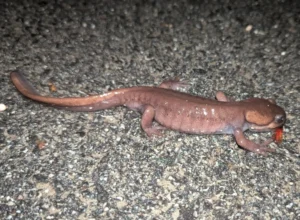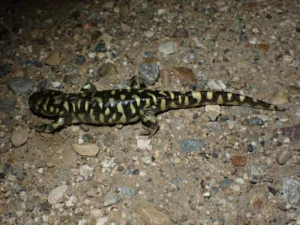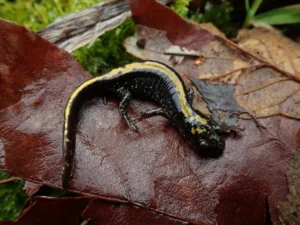Oregon is known for its green forests, misty mountains, and rainy coastlines. It’s a place where rivers cut through mossy valleys, and old trees shade the ground below. In these cool, damp places, salamanders quietly make their homes. If you’ve ever lifted a log or stepped near a forest stream, you may have caught a glimpse of one.
Yes, some salamanders in Oregon are poisonous. They release toxins through their skin to protect themselves from predators, though these poisons are not usually dangerous to humans if handled properly.
These poisons are not meant to harm people. They are meant to send a message to animals: don’t eat me.
But the warning colors and secretions still deserve respect, especially if you have cuts on your hands or forget to wash up after contact.
What Kinds of Salamanders Live in Oregon?
Oregon is home to several native salamander species. Most of them prefer moist, shady places like forests, wetlands, and mountain streams. These salamanders can be hard to spot.
Many stay hidden under logs or rocks, and some only come out at night or during rain.
Here are a few of the best-known salamanders in Oregon:
- Oregon Ensatina (Ensatina eschscholtzii oregonensis)
- Northwestern Salamander (Ambystoma gracile)
- Long-toed Salamander (Ambystoma macrodactylum)
- Coastal Giant Salamander (Dicamptodon tenebrosus)
- Rough-skinned Newt (Taricha granulosa)
Each of these salamanders has adapted to life in Oregon’s wet forests and mountain valleys. Some rely on color and movement to hide from danger. Others use chemical defenses to stay safe.
Which Oregon Salamanders Use Toxins?
Not all salamanders in Oregon are poisonous, but a few do release toxins through their skin. These poisons help protect them from being eaten by birds, snakes, or other animals.
Rough-skinned Newt
The Rough-skinned newt is one of Oregon’s most toxic amphibians. It lives in forests, ponds, and slow-moving streams. It has dark brown or black skin and a bright orange belly. This color pattern is not for decoration. It’s a warning.

This newt’s skin contains tetrodotoxin, a powerful chemical that affects the nervous system. It can cause numbness, tingling, or even serious health problems if ingested.
People should never put their hands in their mouths after touching a Rough-skinned newt. If you have cuts or scrapes, the toxin can enter your body more easily. It’s best not to handle this species at all.
Even so, it’s not aggressive. The poison only affects people if they handle the newt carelessly or try to eat it. Washing your hands after contact is enough to stay safe.
Oregon Ensatina
The Oregon Ensatina is smaller and less toxic than the Rough-skinned newt. It comes in shades of orange, brown, or reddish gray. It lives in wooded areas, often hiding under bark or leaves.

Ensatinas don’t have strong poisons, but their skin still releases chemicals that taste bad to predators. These mild toxins discourage animals from biting or swallowing them.
They use both their dull coloring and their secretions to stay safe. Most animals learn to leave them alone after one bad experience.
Northwestern Salamander
This salamander is large, slow-moving, and dark brown. It lives in wet forests and breeds in ponds or slow streams.
While not very toxic, it can release mild skin secretions that protect it from smaller predators like frogs or insects.

Its size and secretions help it avoid being eaten. But like most salamanders, it depends on staying hidden to stay safe.
Blotched Tiger Salamander
The blotched tiger salamander looks similar to the eastern tiger salamander but has more irregular yellow or olive spots and blotches. These markings spread across its dark, thick body.

It lives in grasslands, woodlands, and near seasonal ponds. Like other tiger salamanders, it produces mild toxins through its skin. These secretions make it taste bad and help keep predators away.
Although it may look bold, it spends most of its time underground or hidden in burrows.
Long-Toed Salamander
The long-toed salamander is easy to spot by the long middle toe on its hind feet and the yellow or greenish stripe that runs along its back. Its dark body is often speckled with lighter spots.

It lives in forests and mountain meadows, often near ponds or streams. Its skin produces sticky secretions that taste unpleasant and discourage predators.
The long-toed salamander avoids danger by hiding under logs and rocks, using its secretions only when necessary.
How Do Salamander Toxins Work?
Salamander poison comes from glands in their skin. These glands slowly release chemicals that coat the skin surface. The toxins are not sprayed or injected.
They work only if a predator tries to bite or swallow the salamander.
In the Rough-skinned newt, tetrodotoxin blocks nerve signals in the body. This can paralyze muscles or affect breathing in animals that eat it. In smaller amounts, it causes numbness or discomfort.
Other salamanders, like the Ensatina or Northwestern salamander, produce weaker toxins. These don’t stop nerves but cause irritation or taste bad enough to make predators spit them out.
All of these poisons are passive defenses. The salamander does not have to fight. It simply waits for the poison to do its job.
Are Oregon Salamanders Dangerous to People?
Most salamanders in Oregon are not dangerous to humans if they are treated with care. However, there are a few safety tips to follow.
If you touch a salamander:
- Do not touch your eyes, nose, or mouth
- Wash your hands with soap and water
- Avoid handling salamanders if you have cuts or scrapes
- Never try to eat one or let children handle them unsupervised
The Rough-skinned newt deserves the most caution. Its toxin is strong enough to cause serious problems if it enters the body through mucous membranes or broken skin.
In most cases, though, touching a salamander briefly with damp hands will not cause harm. Problems arise when people don’t wash their hands or handle the animal roughly.
Can These Salamanders Harm Pets?
Yes. Pets, especially dogs and cats, are naturally curious. They may sniff, lick, or even try to eat a salamander. This can be dangerous.
If a pet comes into contact with a toxic salamander, watch for signs like:
- Drooling
- Vomiting
- Shaking or trembling
- Trouble walking
- Weakness or collapse
These symptoms can appear quickly or take several hours. If you think your pet has touched or eaten a Rough-skinned newt or any other salamander, contact a veterinarian right away.
Keep pets away from forested areas during rainy seasons when salamanders are more active.
Why Do Oregon Salamanders Have Poison?
Salamanders are slow and soft. They have no claws, no teeth for biting, and no shell for protection. Most can’t run fast, and many freeze when frightened.
Their main defense is their skin. Toxins help keep them from being eaten. They tell predators, “This isn’t worth the trouble.”
Bright colors add to that message. Orange bellies, spots, or warning patterns tell animals to stay away.
This is called aposematic coloration, a visual signal that says something is toxic.
It’s simple and effective. One taste is enough to teach a predator not to try again.
Are All Oregon Salamanders Poisonous?
No, not all of them. Some have toxins. Others do not.
Some species rely on hiding instead of warning colors. For example:
Coastal Giant Salamander
This is one of the largest salamanders in North America. It can grow to over a foot long. It lives in cold, clean streams in forested mountain areas.
It can produce mild skin toxins, but its main defense is size and strength. It is one of the few salamanders that can make noise when threatened, letting out a low growl or bark.
Each species has its own way of surviving. Some use poison. Some use camouflage. Some do a little of both.
Conclusion
So, are Oregon salamanders poisonous?
Yes, some salamanders in Oregon produce toxins through their skin to defend themselves from predators. These poisons are not meant to harm humans but should be handled with care and respect.
Hi, my name is Ezra Mushala, i have been interested animals all my life. I am the main author and editor here at snakeinformer.com.

